Exploiting the Applicative Potential of Hydroxyethyl Cellulose-Based Composites by Composition-Tailoring of the Optical and Dielectric Features
Abstract
1. Introduction
2. Materials and Methods
2.1. Basic Materials
2.2. Composite Preparation
2.3. Characterization Techniques
3. Results
3.1. Morphological Analyses
3.2. Colorimetry Tests
3.3. UV-VIS Spectroscopy Investigations
3.4. Refractometry Investigations
3.5. Electrical Properties
4. Conclusions
Author Contributions
Funding
Institutional Review Board Statement
Data Availability Statement
Acknowledgments
Conflicts of Interest
References
- Wellmann, P.J. The search for new materials and the role of novel processing routes. Discov. Mater. 2021, 1, 14. [Google Scholar] [CrossRef] [PubMed]
- Hsissou, R.; Seghiri, R.; Benzekri, Z.; Hilali, M.; Rafik, M.; Elharfi, A. Polymer composite materials: A comprehensive review. Compos. Struct. 2021, 262, 113640. [Google Scholar] [CrossRef]
- Epure, E.-L.; Cojocaru, F.D.; Aradoaei, M.; Ciobanu, R.C.; Dodi, G. Exploring the Surface Potential of Recycled Polyethylene Terephthalate Composite Supports on the Collagen Contamination Level. Polymers 2023, 15, 776. [Google Scholar] [CrossRef]
- Madhushree, M.; Vairavel, P.; Mahesha, G.; Bhat, K.S. A Comprehensive Review of Cellulose and Cellulose-Based Materials: Extraction, Modification, and Sustainable Applications. J. Nat. Fibers 2024, 21, 2418357. [Google Scholar] [CrossRef]
- Etale, A.; Onyianta, A.J.; Turner, S.R.; Eichhorn, S.J. Cellulose: A Review of Water Interactions, Applications in Composites, and Water Treatment. Chem. Rev. 2023, 123, 2016–2048. [Google Scholar] [CrossRef]
- Zakir, M.; Özel, C. Cellulose and its derivatives as biodegradable materials: A review. J. Sci. Rep.-A 2024, 59, 87–104. [Google Scholar]
- Noreen, A.; Zia, K.M.; Tabasum, S.; Khalid, S.; Shareef, R. A review on grafting of hydroxyethylcellulose for versatile applications. Int. J. Biol. Macromol. 2020, 150, 289–303. [Google Scholar] [CrossRef]
- Šimkovic, I.; Gucmann, F.; Dobročka, E.; Filip, J.; Hricovíni, M.; Dujnič, V.; Mendichi, R.; Schieroni, A.G.; Piovani, D.; Zappia, S.; et al. Properties of quaternized and cross-linked hydroxyethylcellulose composite films. Cellulose 2024, 31, 10341–10357. [Google Scholar] [CrossRef]
- Lu, Z.; Huang, J.; E, S.; Li, J.; Si, L.; Yao, C.; Jia, F.; Zhang, M. All cellulose composites prepared by hydroxyethyl cellulose and cellulose nanocrystals through the crosslink of polyisocyanate. Carbohydr. Polym. 2020, 250, 116919. [Google Scholar] [CrossRef]
- Huang, J.; Wang, T.; Su, Y.; Ding, Y.; Tu, C.; Li, W. Hydrophobic MXene/Hydroxyethyl Cellulose/Silicone Resin Composites with Electromagnetic Interference Shielding. Adv. Mater. Interfaces 2021, 8, 2100186. [Google Scholar] [CrossRef]
- Motelica, L.; Ficai, D.; Petrisor, G.; Oprea, O.-C.; Trușcǎ, R.-D.; Ficai, A.; Andronescu, E.; Hudita, A.; Holban, A.M. Antimicrobial Hydroxyethyl-Cellulose-Based Composite Films with Zinc Oxide and Mesoporous Silica Loaded with Cinnamon Essential Oil. Pharmaceutics 2024, 16, 1225. [Google Scholar] [CrossRef]
- Hanif, M.P.M.; Jalilah, A.J.; Badrul, F.; Nuraqmar, S.M.S. The influence of graphite on conductivity, crystallinity and tensile properties of hydroxyethyl cellulose (hec)/graphite composite films. IOP Conf. Ser. Mater. Sci. Eng. 2019, 701, 012015. [Google Scholar] [CrossRef]
- Azha, M.A.S.; Dannoun, E.M.A.; Aziz, S.B.; Kadir, M.F.Z.; Zaki, Z.I.; El-Bahy, Z.M.; Sulaiman, M.; Nofal, M.M. High Cyclability Energy Storage Device with Optimized Hydroxyethyl Cellulose-Dextran-Based Polymer Electrolytes: Structural, Electrical and Electrochemical Investigations. Polymers 2021, 13, 3602. [Google Scholar] [CrossRef] [PubMed]
- Alsubaie, A.S.A. Characterization and Optical Studies of Hydroxyethyl Cellulose-Copper Oxide Nanocomposites. J. Spectrosc. 2022, 2022, 1–9. [Google Scholar] [CrossRef]
- Said, G.S.; Abd-El Kader, F.H.; El Naggar, M.M.; Anees, B.A. Differential scanning calorimetry and dielectric properties of methyl-2-hydroxyethyl cellulose doped with erbium nitrate salt. Carbohydr. Polym. 2006, 65, 253–262. [Google Scholar] [CrossRef]
- Mahmoud, K.H. Optical properties of hydroxyethyl cellulose film treated with nitrogen plasma. Spectrochim. Acta Part A Mol. Biomol. Spectrosc. 2016, 157, 153–157. [Google Scholar] [CrossRef]
- Huang, J.; Hua, L.; Song, L.; Li, J.; E, S.; Lu, Z. Hydroxyethyl cellulose/boron nitride nanosheet films coated with silver nanowires for electronic packaging applications. Mater. Today Sustain. 2023, 21, 100307. [Google Scholar] [CrossRef]
- Ulutas, K.; Yakut, S.; Bozoglu, D.; Tankul, M.I.; Deger, D. Thickness-dependent glass transition temperature of hydroxyethyl cellulose thin films based on dielectric properties. J. Appl. Polym. Sci. 2024, 141, e55185. [Google Scholar] [CrossRef]
- Ma, M.; Mont, F.W.; Yan, X.; Cho, J.; Schubert, E.F.; Kim, G.B.; Sone, C. Effects of the refractive index of the encapsulant on the light-extraction efficiency of light-emitting diodes. Opt. Express 2011, 19, A1135. [Google Scholar] [CrossRef]
- Hoang, A.V.; Jain, B.; Bui, H.Q.T.; Nguyen, H.P.T.; Jude, J.; Tumuna, M.; Velpula, R.T.; Wang, R.; le, T.v.; Pham, T.T.; et al. Enhancing the light extraction efficiency of AlInN nanowire ultraviolet light-emitting diodes with photonic crystal structures. Opt. Express 2020, 28, 22908–22918. [Google Scholar] [CrossRef]
- Yamae, K.; Fukshima, H.; Fujimoto, K. Omnidirectional Reflector with Total Internal Reflective Interface for Light Extraction Enhancement of Solid-State Light Source. Phys. Status Solidi 2019, 216, 1700775. [Google Scholar] [CrossRef]
- Alias, M.S.; Janjua, B.; Zhao, C.; Priante, D.; Alhamoud, A.A.; Tangi, M.; Alanazi, L.M.; Alatawi, A.A.; Albadri, A.M.; Alyamani, A.Y.; et al. Enhancing the Light-Extraction Efficiency of an AlGaN Nanowire Ultraviolet Light-Emitting Diode by Using Nitride/Air Distributed Bragg Reflector Nanogratings. IEEE Photonics J. 2017, 9, 1–8. [Google Scholar] [CrossRef]
- Hulubei, C.; Albu, R.M.; Lisa, G.; Nicolescu, A.; Hamciuc, E.; Hamciuc, C.; Barzic, A.I. Antagonistic effects in structural design of sulfur-based polyimides as shielding layers for solar cells. Sol. Energy Mater. Sol. Cells 2019, 193, 219–230. [Google Scholar] [CrossRef]
- Kim, H.; Ku, B.C.; Goh, M.; Ko, H.C.; Ando, S.; You, N.H. Synergistic Effect of Sulfur and Chalcogen Atoms on the Enhanced Refractive Indices of Polyimides in the Visible and Near-Infrared Regions. Macromolecules 2019, 52, 827–834. [Google Scholar] [CrossRef]
- Ando, S. Organic/inorganic-polyimide nanohybrid materials for advanced opto-electronic applications. In Proceedings of the Organic Photonic Materials and Devices XI; Nelson, R.L., Kajzar, F., Kaino, T., Eds.; SPIE—International Society for Optics and Photonics: Bellingham, WA, USA, 2009; p. 72130B. [Google Scholar]
- Mont, F.W.; Kim, J.K.; Schubert, M.F.; Luo, H.; Schubert, E.F.; Siegel, R.W. High refractive index nanoparticle-loaded encapsulants for light-emitting diodes. In Proceedings of the Light-Emitting Diodes: Research, Manufacturing, and Applications XI, San Jose, CA, USA, 24–25 January 2007; Streubel, K.P., Jeon, H., Eds.; SPIE: Bellingham, WA, USA, 2007; Volume 6486, p. 64861C. [Google Scholar]
- Mont, F.W.; Kim, J.K.; Schubert, M.F.; Schubert, E.F.; Siegel, R.W. High-refractive-index TiO2-nanoparticle-loaded encapsulants for light-emitting diodes. J. Appl. Phys. 2008, 103, 083120. [Google Scholar] [CrossRef]
- Möls, K.; Aarik, L.; Mändar, H.; Kasikov, A.; Niilisk, A.; Rammula, R.; Aarik, J. Influence of phase composition on optical properties of TiO2: Dependence of refractive index and band gap on formation of TiO2-II phase in thin films. Opt. Mater. 2019, 96, 109335. [Google Scholar] [CrossRef]
- Feng, X.; Wang, X.; Chen, X.; Yue, Y. Thermo-physical properties of thin films composed of anatase TiO2 nanofibers. Acta Mater. 2011, 59, 1934–1944. [Google Scholar] [CrossRef]
- Ayorinde, T.; Sayes, C.M. An updated review of industrially relevant titanium dioxide and its environmental health effects. J. Hazard. Mater. Lett. 2023, 4, 100085. [Google Scholar] [CrossRef]
- Araki, S.M.; Baby, A.R. New Perspectives on Titanium Dioxide and Zinc Oxide as Inorganic UV Filters: Advances, Safety, Challenges, and Environmental Considerations. Cosmetics 2025, 12, 77. [Google Scholar] [CrossRef]
- Evans, S.J.; Lawrence, R.L.; Ilett, M.; Burgum, M.J.; Meldrum, K.; Hondow, N.; Jenkins, G.J.; Clift, M.J.D.; Doak, S.H. Industrial-relevant TiO2 types do not promote cytotoxicity in the A549 or TK6 cell lines regardless of cell specific interaction. Toxicol. Vitr. 2022, 83, 105415. [Google Scholar] [CrossRef]
- Arif, M.; Javed, M.; Akhter, T. Crosslinked polymeric networks of TiO2—Polymer composites: A comprehensive review. RSC Adv. 2024, 14, 33843–33863. [Google Scholar] [CrossRef]
- Matsuzawa, S.; Maneerat, C.; Hayata, Y.; Hirakawa, T.; Negishi, N.; Sano, T. Immobilization of TiO2 nanoparticles on polymeric substrates by using electrostatic interaction in the aqueous phase. Appl. Catal. B Environ. 2008, 83, 39–45. [Google Scholar] [CrossRef]
- Cazan, C.; Enesca, A.; Andronic, L. Synergic Effect of TiO2 Filler on the Mechanical Properties of Polymer Nanocomposites. Polymers 2021, 13, 2017. [Google Scholar] [CrossRef]
- Hamming, L.M.; Qiao, R.; Messersmith, P.B.; Catherine Brinson, L. Effects of dispersion and interfacial modification on the macroscale properties of TiO2 polymer–matrix nanocomposites. Compos. Sci. Technol. 2009, 69, 1880–1886. [Google Scholar] [CrossRef] [PubMed]
- Basiev, T.T.; Danileiko, Y.K.; Dmitruk, L.N.; Galagan, B.I.; Moiseeva, L.V.; Osiko, V.V.; Sviridova, E.E.; Vinogradova, N.N. The purification, crystal growth, and spectral-luminescent properties of PbCl2:RE. Opt. Mater. 2004, 25, 295–299. [Google Scholar] [CrossRef]
- Okpala, U.V.; Ezema, F.I.; Osuji, R.U. A study of the optical properties of un-doped and potash doped lead chloride crystal in silica gel. Dig. J. Nanomater. Biostruct. 2012, 7, 103–109. [Google Scholar]
- Tyagi, M.; Suri, G.; Chhabra, P.; Seshadri, G.; Malik, A.; Aggarwal, S.; Khandal, R.K. Novel way of making high refractive index plastics; metal containing polymers for optical applications. e-Polymers 2009, 9, 1197–1214. [Google Scholar] [CrossRef]
- Batool, M.; Naz, S.; Chatha, A.M.M.; Ain, Q.U.; Irshad, A.; Mahmood, M.; Aziz, A.; Abbas, G.; Yasmin, F. Toxic Effects of Lead Chloride (PbCl2) on Behavioral, Hematological, and Serum Biochemical Parameters in Labeo rohita. Biosci. Rev. 2024, 6, 57–76. [Google Scholar] [CrossRef]
- Amraeinia, A.; Zuo, Y.; Zheng, J.; Liu, Z.; Zhang, G.; Luo, L.; Cheng, B.; Zou, X.; Li, C. Interface modification of TiO2 electron transport layer with PbCl2 for perovskiote solar cells with carbon electrode. Tsinghua Sci. Technol. 2022, 27, 741–750. [Google Scholar] [CrossRef]
- Liedermann, K.; Lapčík, L. Dielectric relaxation in hydroxyethyl cellulose. Carbohydr. Polym. 2000, 42, 369–374. [Google Scholar] [CrossRef]
- Alexe-Ionescu, A.L.; Barbero, G.; Freire, F.C.M.; Merletti, R. Effect of composition on the dielectric properties of hydrogels for biomedical applications. Physiol. Meas. 2010, 31, S169–S182. [Google Scholar] [CrossRef] [PubMed]
- Barzic, A.I.; Stoica, I.; Asandulesa, M.; Albu, R.M.; Oprisan, B. Bentonite/hydroxyethylcellulose as eco-dielectrics with potential utilization in energy storage. e-Polymers 2023, 23, 20230073. [Google Scholar] [CrossRef]
- Zheng, X.; Yin, Y.; Wang, P.; Sun, C.; Yang, Q.; Shi, Z.; Xiong, C. High-performance dielectric film capacitors based on cellulose/Al2O3 nanosheets/PVDF composites. Int. J. Biol. Macromol. 2023, 243, 125220. [Google Scholar] [CrossRef]
- Voignac, D.; Belsey, S.; Wermter, E.; Paltiel, Y.; Shoseyov, O. Biobased Electronics: Tunable Dielectric and Piezoelectric Cellulose Nanocrystal—Protein Films. Nanomaterials 2023, 13, 2258. [Google Scholar] [CrossRef] [PubMed]
- Sunil Kumar Sandhya Rani Nagarajaiah Raghu, S.; Sandeep Dongre Demappa Thippaiah, S.J. Dielectric and Conductivity Study of Salt-Doped HPMC Solid Polymer Electrolyte Films. Biointerface Res. Appl. Chem. 2023, 13, 529. [Google Scholar] [CrossRef]
- Ramlli, M.A.; Isa, M.I.N.M.; Kamarudin, K.H. 2-Hydroxyethyl Cellulose-Ammonium Thiocyanate Solid Biopolymer Electrolytes: Ionic Conductivity and Dielectric Studies. J. Sustain. Sci. Manag. 2022, 17, 121–132. [Google Scholar] [CrossRef]
- Beyler Çiğil, A.; Şen, F.; Birtane, H.; Kahraman, M.V. Covalently bonded nanosilver-hydroxyethyl cellulose/polyacrylic acid/sorbitol hybrid matrix: Thermal, morphological and antibacterial properties. Polym. Bull. 2022, 79, 11353–11368. [Google Scholar] [CrossRef]
- Sudhakar, Y.N.; Selvakumar, M.; Bhat, D.K. Preparation and characterization of phosphoric acid-doped hydroxyethyl cellulose electrolyte for use in supercapacitor. Mater. Renew. Sustain. Energy 2015, 4, 10. [Google Scholar] [CrossRef]
- Albu, R.M.; Barzic, A.I.; Asandulesa, M.; Rusu, B.-G.; Stoica, I.; Sava, I. Insights into Interfacial Features of Metal/Eco-Composites Designed for Energy Storage. Coatings 2023, 13, 1390. [Google Scholar] [CrossRef]
- Lukianoqicz, C. Analysis of light scattering by rough manufactured surfaces. Precis. Eng. 1985, 7, 67–71. [Google Scholar] [CrossRef]
- Song, G.; Wang, Y.; Tan, D.Q. A review of surface roughness impact on dielectric film properties. IET Nanodielectr. 2022, 5, 1–23. [Google Scholar] [CrossRef]
- Choudhury, A.K.R. Using instruments to quantify colour. In Principles of Colour and Appearance Measurement; Elsevier: Amsterdam, The Netherlands, 2014; pp. 270–317. [Google Scholar]
- Ohta, N.; Robertson, A.R. Colorimetry: Fundamentals and Applications, 1st ed.; Wiley: Chichester, NH, USA, 2005; Volume 30, ISBN 3175723993. [Google Scholar]
- Ananda, H.T.; Urs, G.T.; Somashekar, R. Preparation and characterization of conductive PVA/Gly:Na2SO4 polymer composites. Polym. Bull. 2016, 73, 1151–1165. [Google Scholar] [CrossRef]
- Aziz, S.B.; Dannoun, E.M.A.; Tahir, D.A.; Hussen, S.A.; Abdulwahid, R.T.; Nofal, M.M.; Abdullah, R.M.; Hussein, A.; Brevik, I. Synthesis of PVA/CeO2 Based Nanocomposites with Tuned Refractive Index and Reduced Absorption Edge: Structural and Optical Studies. Materials 2021, 14, 1570. [Google Scholar] [CrossRef]
- Aziz, S.B.; Hussein, S.; Hussein, A.M.; Saeed, S.R. Optical Characteristics of Polystyrene Based Solid Polymer Composites: Effect of Metallic Copper Powder. Int. J. Met. 2013, 2013, 1–6. [Google Scholar] [CrossRef]
- Tauc, J. Optical Properties and Electronic Structure of Amorphous Semiconductors. In Optical Properties of Solids; Springer: Boston, MA, USA, 1969; pp. 123–136. ISBN 9781139094337. [Google Scholar]
- Ayik, C.; Studenyak, I.; Kranjec, M.; Kurik, M. Urbach Rule in Solid State Physics. Int. J. Opt. Appl. 2014, 4, 76–83. [Google Scholar] [CrossRef]
- Morsi, M.A.; Abdelaziz, M.; Oraby, A.H.; Mokhles, I. Structural, optical, thermal, and dielectric properties of polyethylene oxide/carboxymethyl cellulose blend filled with barium titanate. J. Phys. Chem. Solids 2019, 125, 103–114. [Google Scholar] [CrossRef]
- Tauc, J.; Menth, A. States in the gap. J. Non. Cryst. Solids 1972, 8–10, 569–585. [Google Scholar] [CrossRef]
- Dorohoi, D.O.; Postolache, M.; Nechifor, C.D.; Dimitriu, D.G.; Albu, R.M.; Stoica, I.; Barzic, A.I. Review on Optical Methods Used to Characterize the Linear Birefringence of Polymer Materials for Various Applications. Molecules 2023, 28, 2955. [Google Scholar] [CrossRef]
- Nussbaumer, R.J.; Caseri, W.R.; Smith, P.; Tervoort, T. Polymer-TiO2 Nanocomposites: A Route Towards Visually Transparent Broadband UV Filters and High Refractive Index Materials. Macromol. Mater. Eng. 2003, 288, 44–49. [Google Scholar] [CrossRef]
- Barzic, A.I.; Soroceanu, M.; Rotaru, R.; Doroftei, F.; Asandulesa, M.; Tugui, C.; Dascalu, I.A.; Harabagiu, V. Cellulose derivative/barium titanate composites with high refractive index, conductivity and energy density. Cellulose 2022, 29, 863–878. [Google Scholar] [CrossRef]
- Li, X.; Xu, J. A Simple Synthesis of Higher Refractive Index Polymeric Nanocomposite Containing the Pendant ZnS Nanocrystals Capping Different Amount of Mercaptoethanol. J. Nanomater. 2020, 2020, 1–13. [Google Scholar] [CrossRef]
- Bhat, V.S.; Kapatkar, S.B.; Naik, I.; Hegde, S. Investigation of impact of Al2O3 nanoparticles on optical, electrical and structural properties of PFO/PMMA films for optoelectronic applications. Discov. Mater. 2025, 5, 68. [Google Scholar] [CrossRef]
- Barbieri, D.; de Bruijn, J.D.; Luo, X.; Farè, S.; Grijpma, D.W.; Yuan, H. Controlling dynamic mechanical properties and degradation of composites for bone regeneration by means of filler content. J. Mech. Behav. Biomed. Mater. 2013, 20, 162–172. [Google Scholar] [CrossRef]
- Clark, G.D.; Holonyak, N. Optical Properties of Gallium Arsenide-Phosphide. Phys. Rev. 1967, 156, 913–924. [Google Scholar] [CrossRef]
- Malitson, I.H. Interspecimen Comparison of the Refractive Index of Fused Silica. J. Opt. Soc. Am. 1965, 55, 1205. [Google Scholar] [CrossRef]
- Wang, L.; Wang, Z.; Yang, H.; Yang, G. The study of thermal stability of the SiO2 powders with high specific surface area. Mater. Chem. Phys. 1999, 57, 260–263. [Google Scholar] [CrossRef]
- Ding, Z.; Yang, Q.; Yan, X.; Gu, F.; Huang, X.; Cai, Z. Preparation and Characterization of Biobased Dehydroabietyl Polyethylene Glycol Glycidyl Ether-Grafted Hydroxyethyl Cellulose with High Emulsifying Property. J. Renew. Mater. 2024, 12, 103–117. [Google Scholar] [CrossRef]
- Lyon, B.; DiMarino, C. Investigation and Evaluation of High-Temperature Encapsulation Materials for Power Module Applications. J. Microelectron. Electron. Package 2023, 20, 89–94. [Google Scholar] [CrossRef]
- Choi, H.-S.; Park, J.-S.; Moon, C.-H. Improvement of Light Extraction Efficiency of LED Packages Using an Enhanced Encapsulant Design. J. Opt. Soc. Korea 2014, 18, 370–376. [Google Scholar] [CrossRef]
- Lee, B.K.; Goh, K.S.; Chin, Y.L.; Tan, C.W. Light Emitting Diode with Gradient Index Layering. U.S. Patent 6,717,362, 6 April 2004. [Google Scholar]
- Popov, I.; Sokolov, A.P. Fundamentals of Dielectric Spectroscopy in Polymer Nanocomposites. In Dynamics of Composite Materials. Advances in Dielectrics; Schönhals, A., Szymoniak, P., Eds.; Springer: Cham, Switzerland, 2022; pp. 35–61. [Google Scholar]
- Padurariu, L.; Brunengo, E.; Canu, G.; Curecheriu, L.P.; Conzatti, L.; Buscaglia, M.T.; Stagnaro, P.; Mitoseriu, L.; Buscaglia, V. Role of Microstructures in the Dielectric Properties of PVDF-Based Nanocomposites Containing High-Permittivity Fillers for Energy Storage. ACS Appl. Mater. Interfaces 2023, 15, 13535–13544. [Google Scholar] [CrossRef]
- Yin, Y.; Zhang, C.; Chen, J.; Yu, W.; Shi, Z.; Xiong, C.; Yang, Q. Cellulose/BaTiO3 nanofiber dielectric films with enhanced energy density by interface modification with poly(dopamine). Carbohydr. Polym. 2020, 249, 116883. [Google Scholar] [CrossRef]
- Liu, Y.; Liu, W.; Zhou, Y.; Chen, J.; Wang, Z.; Du, W.; Wen, J.; Cao, J.; Zhang, D. Enhanced dielectric constant and breakdown strength in dielectric composites using TiO2@HfO2 nanowires with gradient dielectric constant. Ceram. Int. 2022, 48, 12483–12489. [Google Scholar] [CrossRef]
- Padurariu, L.; Horchidan, N.; Ciomaga, C.E.; Curecheriu, L.P.; Lukacs, V.A.; Stirbu, R.S.; Stoian, G.; Botea, M.; Florea, M.; Maraloiu, V.A.; et al. Influence of Ferroelectric Filler Size and Clustering on the Electrical Properties of (Ag–BaTiO3)–PVDF Sub-Percolative Hybrid Composites. ACS Appl. Mater. Interfaces 2023, 15, 5744–5759. [Google Scholar] [CrossRef]
- Barzic, A.I.; Stoica, I.; Asandulesa, M.; Albu, R.M. Novel polymer/bio-filler composites as alternative eco-friendly materials for energy storage: From solution behavior to solid state analysis. Mater. Today Chem. 2023, 34, 101807. [Google Scholar] [CrossRef]
- Tan, L.; Su, K.; Quan, H.; Han, R.; Wang, Y.; Gao, D.; Zhou, Z.; Li, Q.; Chen, G.-X. Optimizing the dielectric properties of polymer composites by constructing multi-dimensional fillers. Polymer 2024, 312, 127658. [Google Scholar] [CrossRef]
- Cazacu, A.; Curecheriu, L.; Neagu, A.; Padurariu, L.; Cernescu, A.; Lisiecki, I.; Mitoseriu, L. Tunable gold-chitosan nanocomposites by local field engineering. Appl. Phys. Lett. 2013, 102, 222903-1–222903-15. [Google Scholar] [CrossRef]
- Hadjichristov, G.B.; Kovacheva, D.G.; Marinov, Y.G.; Karashanova, D.B.; Vlakhov, T.E.; Scaramuzza, N. Dielectric spectroscopy characterization of Na+ ion-conducting polymer nanocomposite system PEO–PVP–NaIO4–TiO2. J. Adv. Dielectr. 2024, 14, 2350021. [Google Scholar] [CrossRef]
- Pritam; Arya, A.; Sharma, A.L. Dielectric relaxations and transport properties parameter analysis of novel blended solid polymer electrolyte for sodium-ion rechargeable batteries. J. Mater. Sci. 2019, 54, 7131–7155. [Google Scholar] [CrossRef]
- Kumar, K.N.; Kang, M.; Sivaiah, K.; Ravi, M.; Ratnakaram, Y.C. Enhanced electrical properties of polyethylene oxide (PEO) + polyvinylpyrrolidone (PVP): Li+ blended polymer electrolyte films with addition of Ag nanofiller. Ionics 2016, 22, 815–825. [Google Scholar] [CrossRef]

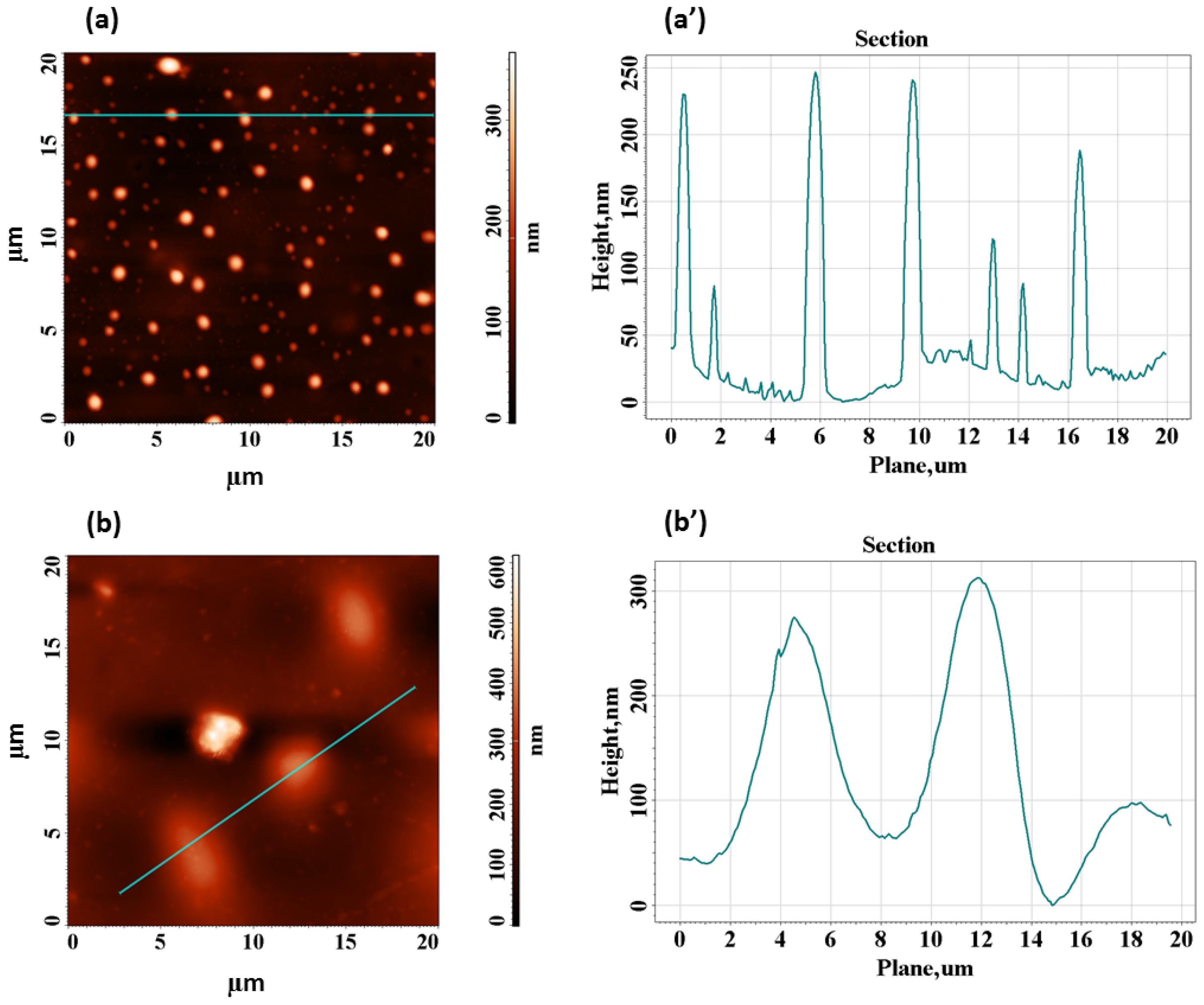
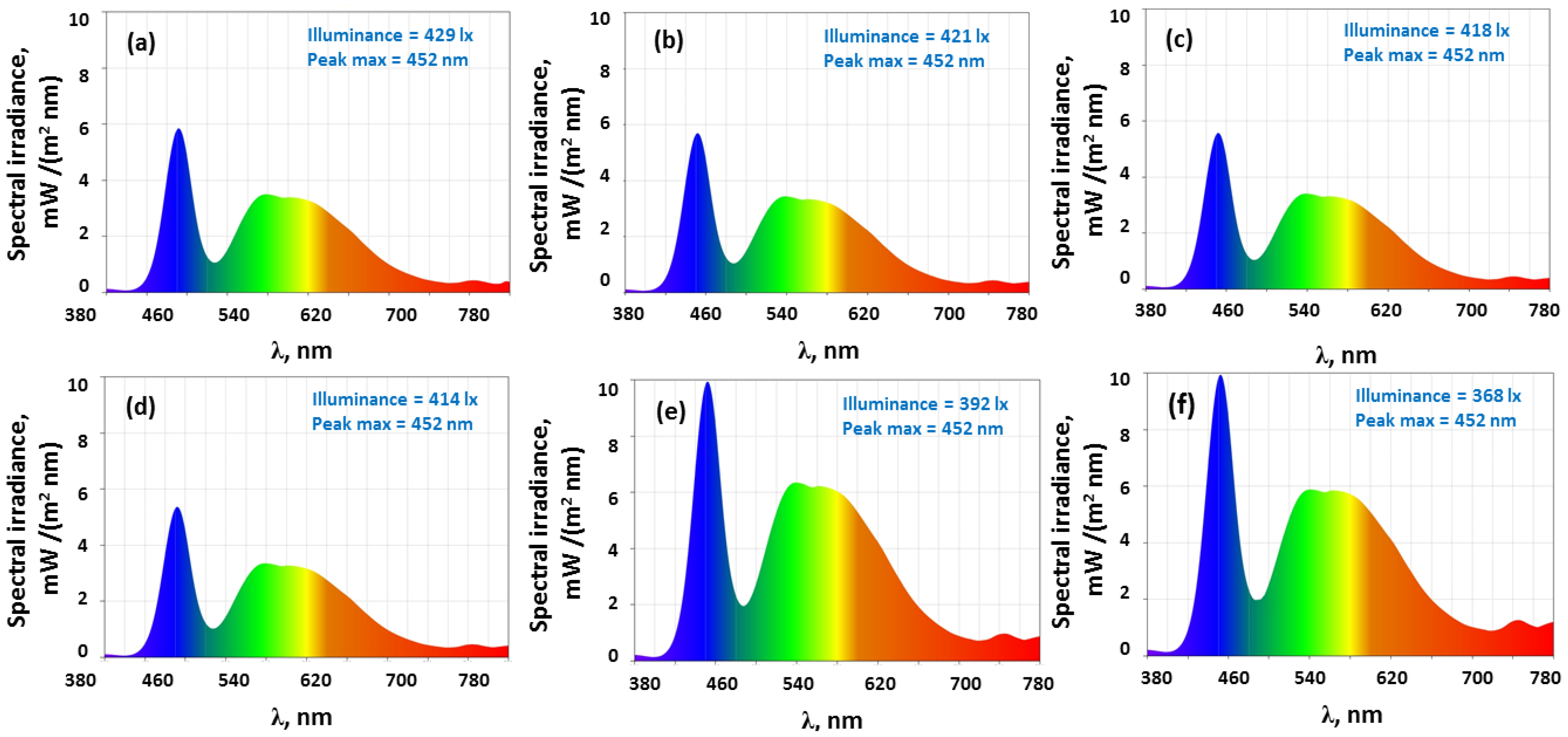
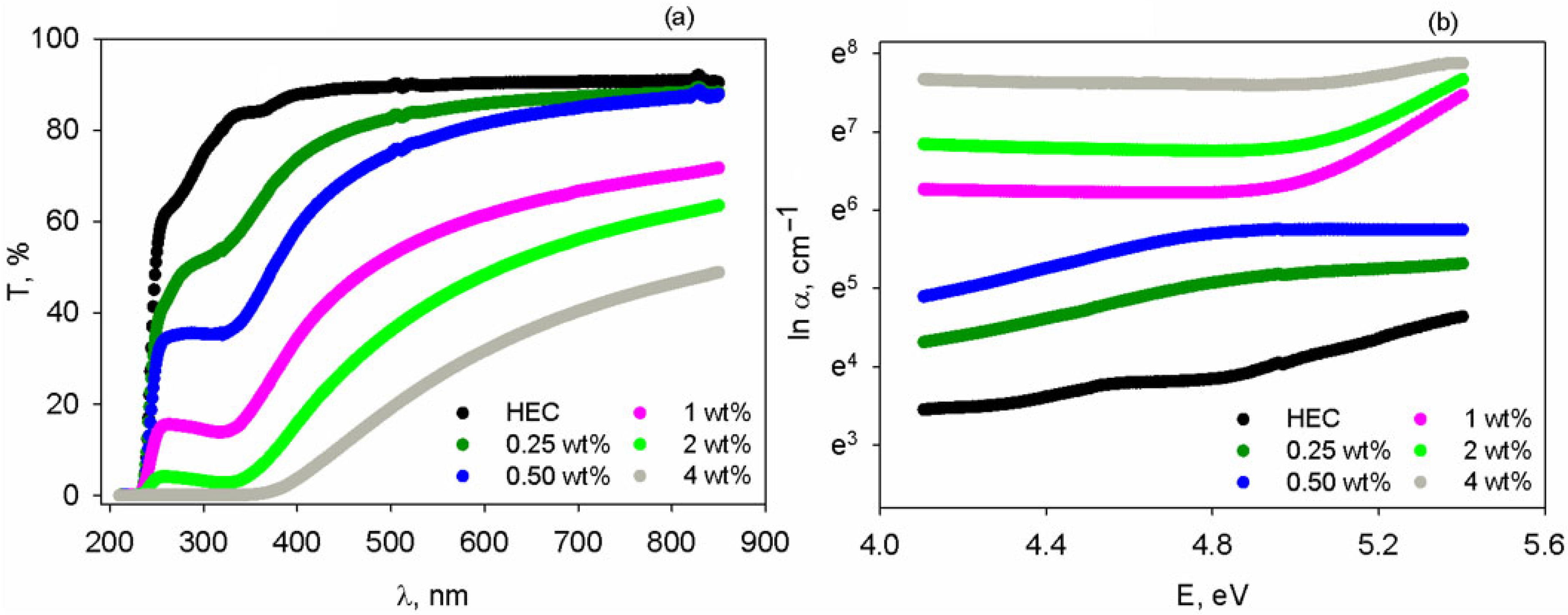
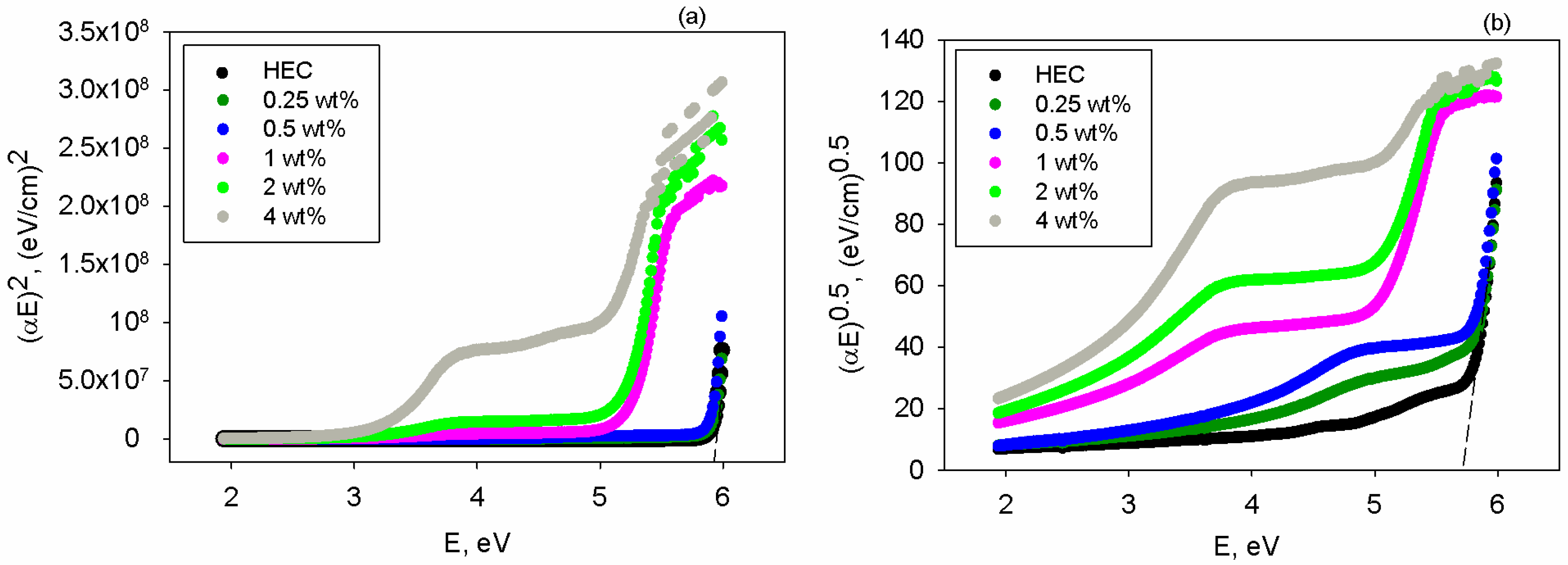


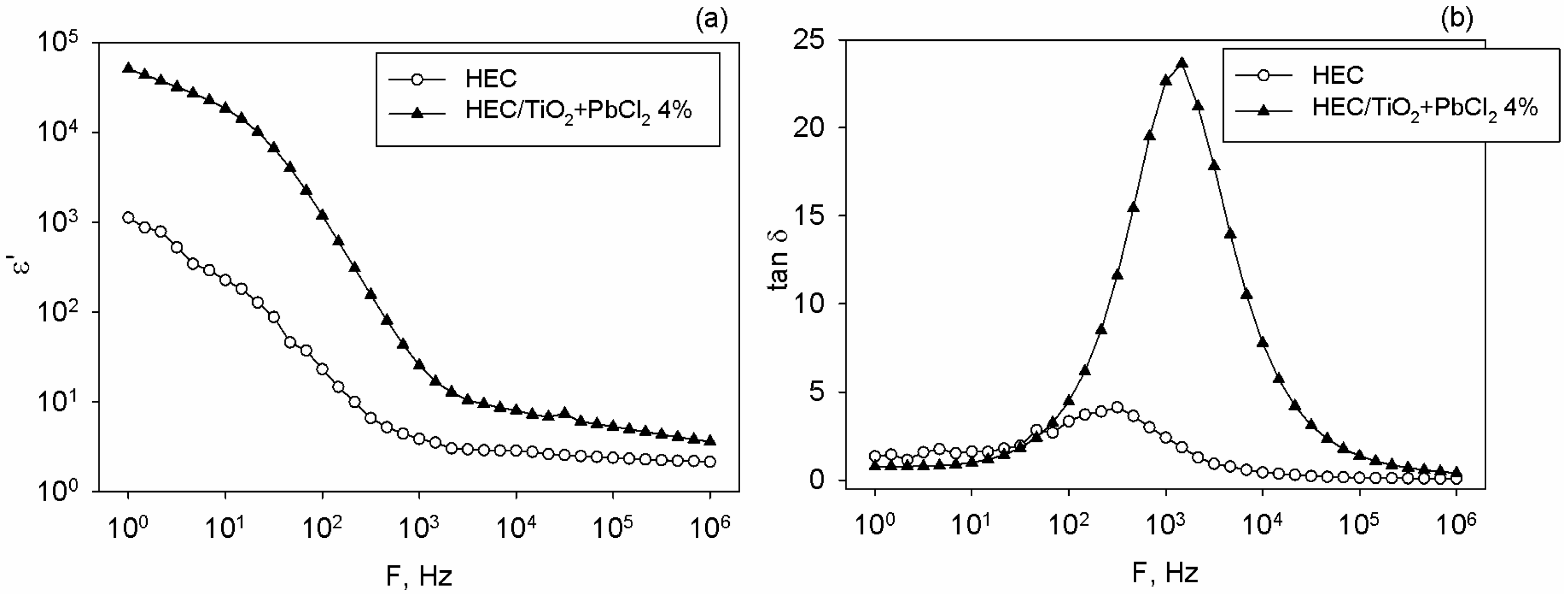
| Fillers, wt% | X | Y | Z | Tct | L* | a* | b* |
|---|---|---|---|---|---|---|---|
| 0 | 412.2346 | 429.0546 | 468.3194 | 6403 | 97.0355 | 0.1021 | 0.6193 |
| 0.25 | 404.4324 | 421.4169 | 456.9671 | 6370 | 96.3608 | −0.0836 | 1.0386 |
| 0.50 | 401.1617 | 418.4498 | 448.3822 | 6302 | 96.0964 | −0.2532 | 1.7971 |
| 1 | 394.3654 | 412.2261 | 432.4244 | 6189 | 95.5379 | −0.5884 | 3.1331 |
| 2 | 375.1916 | 392.0748 | 401.9121 | 6047 | 93.6900 | −0.5349 | 4.5054 |
| 4 | 351.8888 | 367.8314 | 347.6491 | 5622 | 91.3809 | −0.5689 | 9.2374 |
| Fillers, wt% | h, µm | Eu, meV | Eg-d, eV | Eg-i, eV |
|---|---|---|---|---|
| 0 | 39 | 1137.66 | 5.94 | 5.73 |
| 0.25 | 35 | 1184.83 | 5.87 | 5.66 |
| 0.50 | 35 | 1381.22 | 5.80 | 5.56 |
| 1 | 37 | 1605.14 | 5.31 | 4.83 |
| 2 | 37 | 2666.67 | 5.15 | 4.65 |
| 4 | 37 | 4761.91 | 4.75 | 3.79 |
Disclaimer/Publisher’s Note: The statements, opinions and data contained in all publications are solely those of the individual author(s) and contributor(s) and not of MDPI and/or the editor(s). MDPI and/or the editor(s) disclaim responsibility for any injury to people or property resulting from any ideas, methods, instructions or products referred to in the content. |
© 2025 by the authors. Licensee MDPI, Basel, Switzerland. This article is an open access article distributed under the terms and conditions of the Creative Commons Attribution (CC BY) license (https://creativecommons.org/licenses/by/4.0/).
Share and Cite
Barzic, A.I.; Stoica, I.; Albu, R.M.; Belotercovschii, I.; Suman, V.; Zalamai, V.V.; Cojocaru, V. Exploiting the Applicative Potential of Hydroxyethyl Cellulose-Based Composites by Composition-Tailoring of the Optical and Dielectric Features. Polymers 2025, 17, 2315. https://doi.org/10.3390/polym17172315
Barzic AI, Stoica I, Albu RM, Belotercovschii I, Suman V, Zalamai VV, Cojocaru V. Exploiting the Applicative Potential of Hydroxyethyl Cellulose-Based Composites by Composition-Tailoring of the Optical and Dielectric Features. Polymers. 2025; 17(17):2315. https://doi.org/10.3390/polym17172315
Chicago/Turabian StyleBarzic, Andreea Irina, Iuliana Stoica, Raluca Marinica Albu, Igori Belotercovschii, Victor Suman, Victor V. Zalamai, and Victor Cojocaru. 2025. "Exploiting the Applicative Potential of Hydroxyethyl Cellulose-Based Composites by Composition-Tailoring of the Optical and Dielectric Features" Polymers 17, no. 17: 2315. https://doi.org/10.3390/polym17172315
APA StyleBarzic, A. I., Stoica, I., Albu, R. M., Belotercovschii, I., Suman, V., Zalamai, V. V., & Cojocaru, V. (2025). Exploiting the Applicative Potential of Hydroxyethyl Cellulose-Based Composites by Composition-Tailoring of the Optical and Dielectric Features. Polymers, 17(17), 2315. https://doi.org/10.3390/polym17172315







